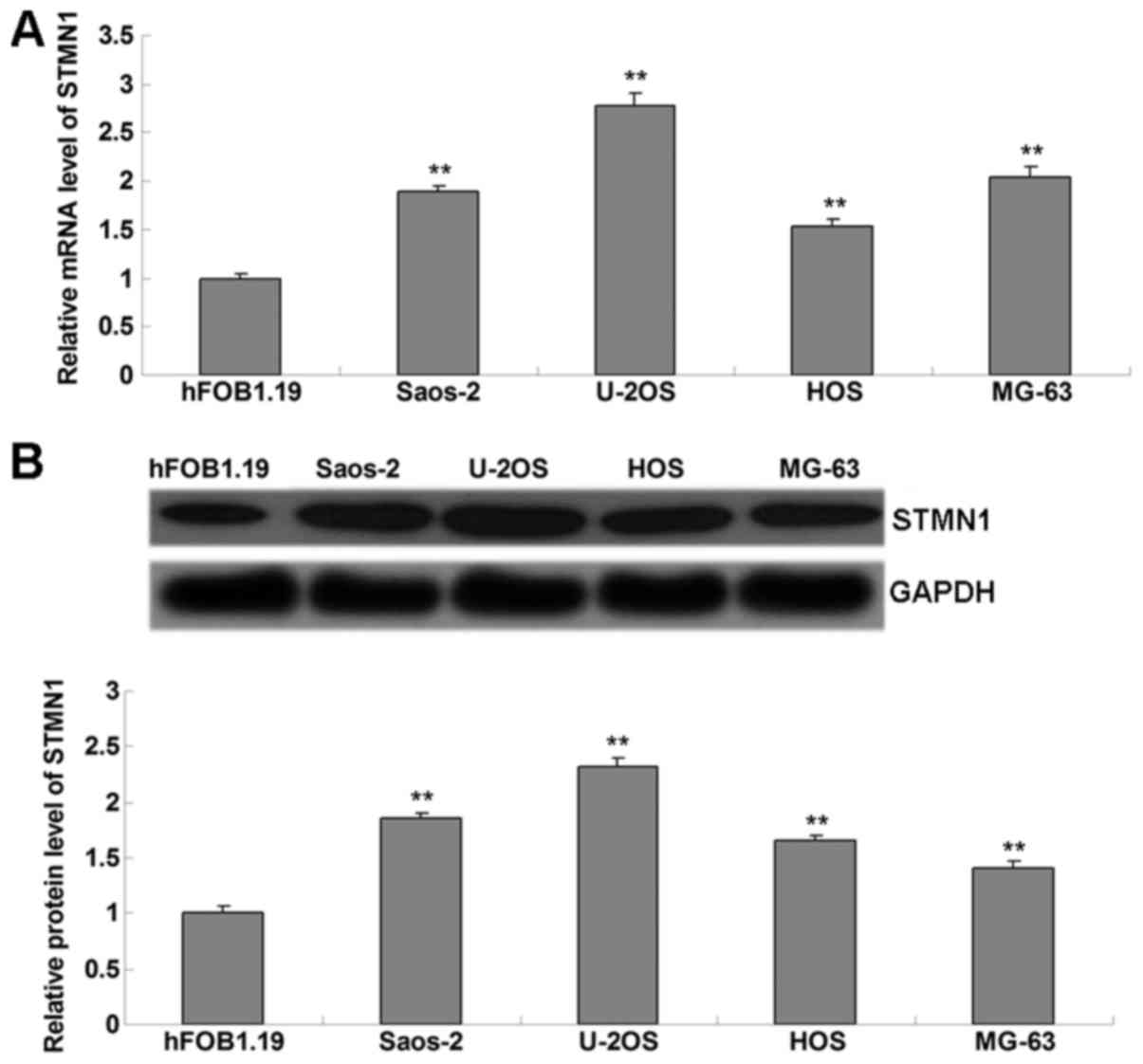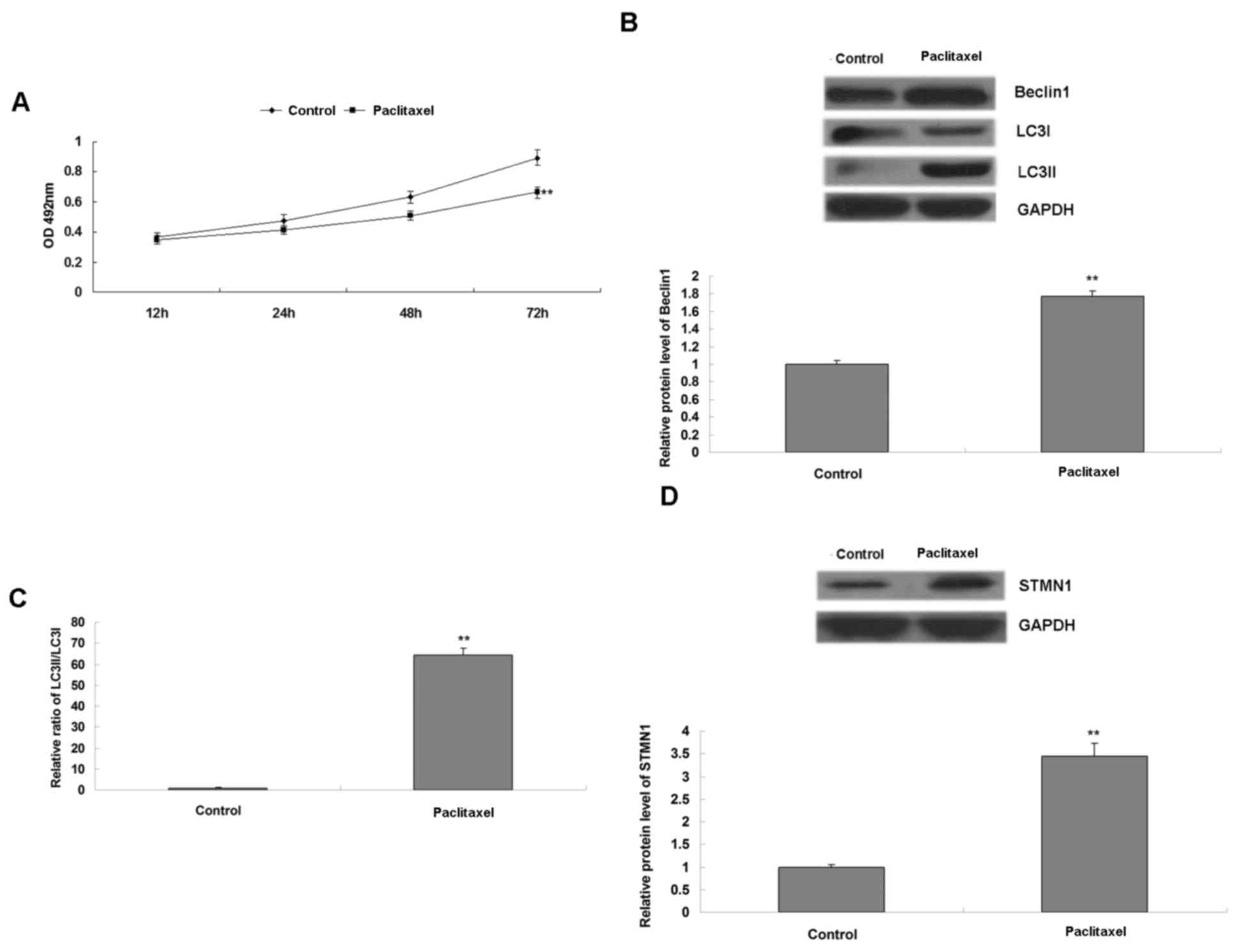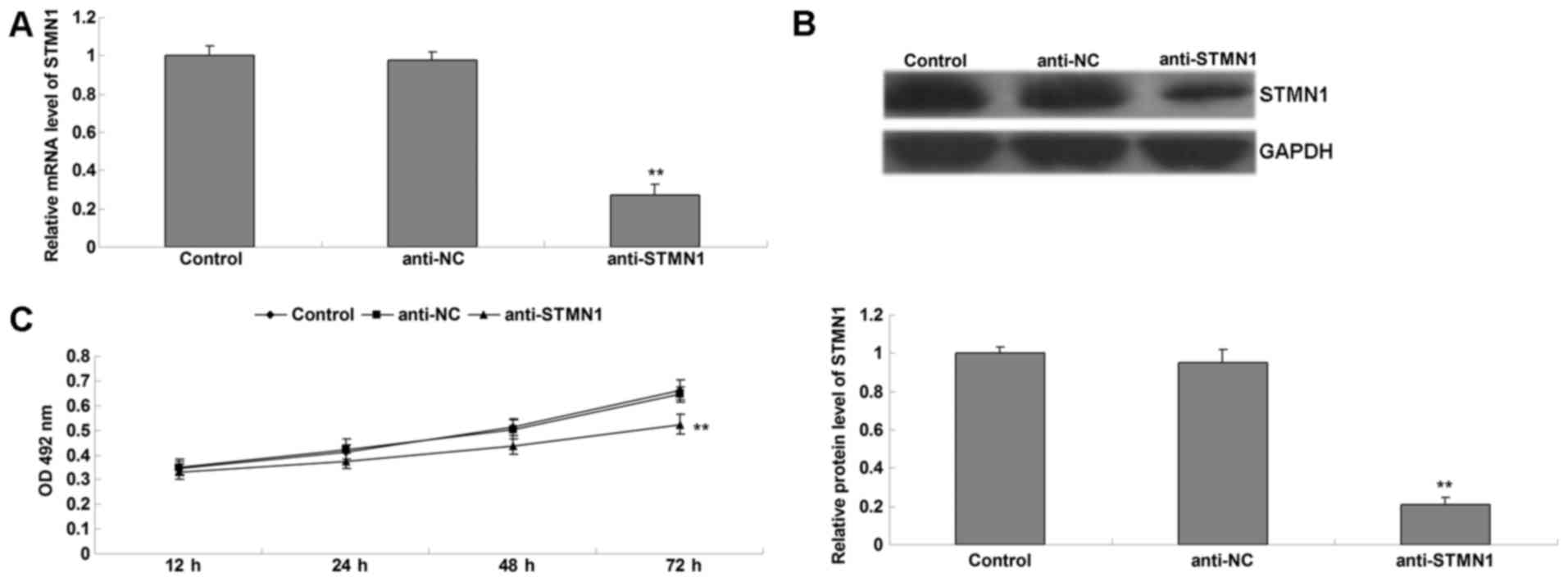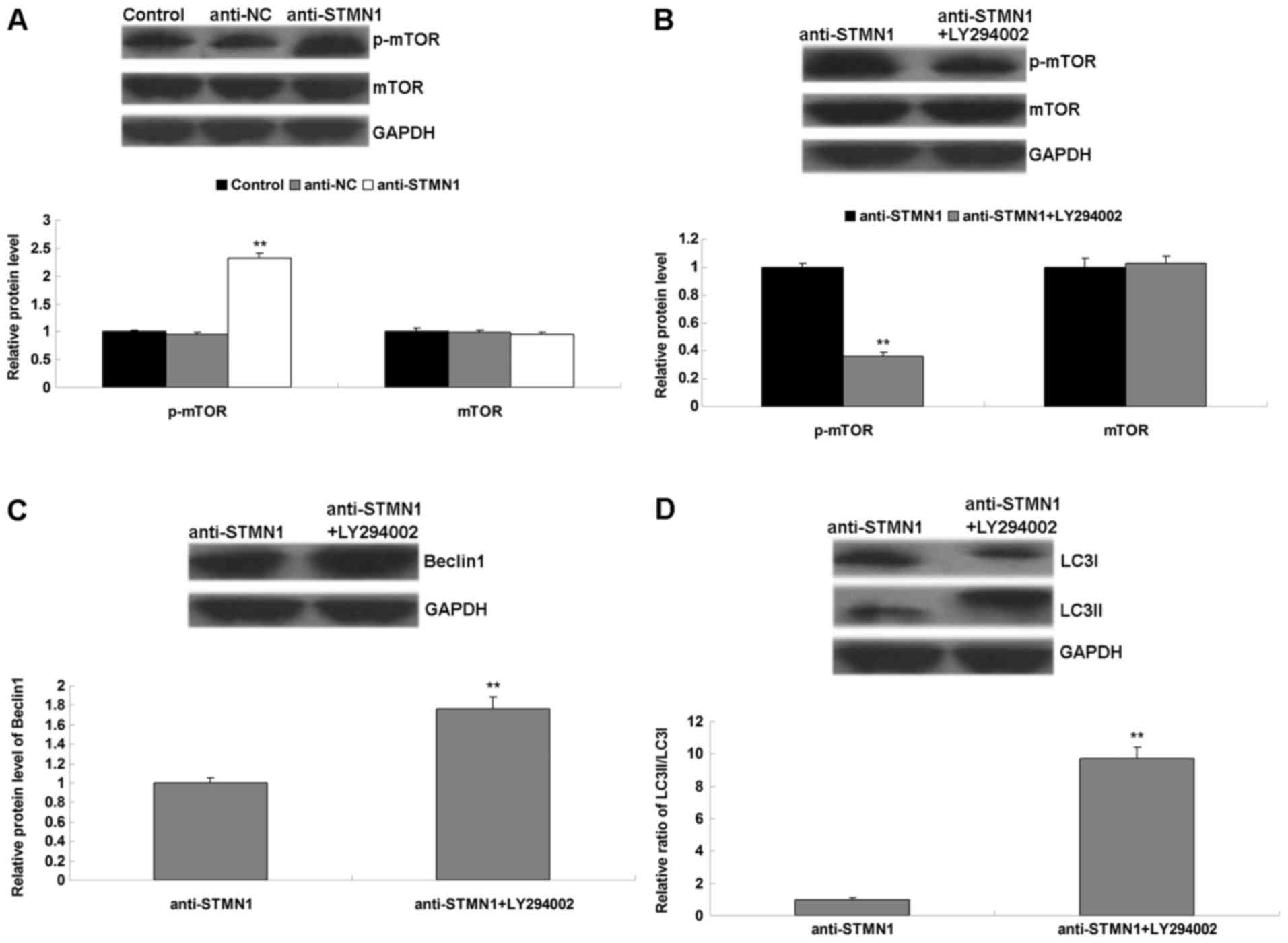Knockdown of STMN1 enhances osteosarcoma cell chemosensitivity through inhibition of autophagy
- Authors:
- Published online on: March 28, 2017 https://doi.org/10.3892/ol.2017.5941
- Pages: 3465-3470
-
Copyright: © Wang et al. This is an open access article distributed under the terms of Creative Commons Attribution License.
Abstract
Introduction
As the most common mesenchymal sarcoma in bone, osteosarcoma (OS) mainly arises from the metaphysis of the long bones (1). Although great efforts have been made in OS diagnosis and therapy, chemoresistance remains a major problem that causes low 5-year survival rates (1). Furthermore, the understanding of the mechanism underlying chemoresistance is limited. It has been demonstrated that various oncogenes and tumor suppressors are involved in chemoresistance (2–4). Thus, investigation into the molecular targets involved in OS cell chemoresistance is urgently required.
Autophagy, an evolutionarily conserved function, is a cellular self-catabolic degradation process, responsible for the lysosomal degradation of long-lived proteins as well as aged or damaged organelles (5). The amino acids and fatty acids generated during autophagy may be reused and thus autophagy may be beneficial for sustainable cell survival (6). Accumulating evidence has been reported that autophagy is rapidly activated when cancer cells are treated with certain chemotherapy drugs (7,8), and functions as a protective mechanism to promote cancer cell survival (5). Therefore, autophagy frequently contributes to chemoresistance, and inhibition of autophagy has been observed to promote chemotherapy efficacy (9).
Stathmin 1 (STMN1), a cytosolic phosphoprotein, has been reported to be abundantly expressed in various cell types (10,11). Furthermore, STMN1 is able to regulate microtubule dynamics by promoting depolymerization of microtubules and/or preventing polymerization of tubulin heterodimers (12). Therefore, anti-STMN1 therapy has been reported to improve sensitivity to antimicrotubule drugs in esophageal squamous cell carcinoma (12). Zhang et al (13) reported that the expression of STMN1 was significantly increased in two human OS cell lines (SOSP-9607 and SOSP-9901) and 45 OS tissue specimens, compared with normal tissues. It was also demonstrated that knockdown of STMN1 inhibited OS cell proliferation and cell cycle progression, while inducing apoptosis (13), suggesting that STMN1 may act as an oncogene in OS. Phadke et al (14) evaluated the in vivo safety and antitumor efficacy of bifunctional small hairpin RNAs specific for STMN1. The results of this previous study confirmed the systemic safety of the therapeutic dose, and thus supported the early-phase assessments of clinical safety and preliminary efficacy (14). However, to the best of our knowledge, there have been no reports of the role of STMN1 in the regulation of chemosensitivity in OS.
The present study aimed to investigate the effect of STMN1 on paclitaxel-induced chemoresistance, as well as the underlying mechanism of action.
Materials and methods
Cell culture
OS cell lines HOS, Saos-2, U-2OS and MG-63, and normal osteoblast cell line hFOB1.19, were obtained from American Type Culture Collection (Manassas, VA, USA). All cell lines were cultured in Dulbecco's modified Eagle's medium (Thermo Fisher Scientific, Inc., Waltham, MA, USA) with 10% fetal bovine serum (Thermo Fisher Scientific, Inc.) at 37°C in a humidified incubator containing 5% CO2.
Cell transfection or treatment
The recombinant lentivirus anti-STMN1 (GeneChem Co., Ltd., Shanghai, China), as well as the control anti-NC (negative control; GeneChem Co., Ltd.) were transfected into U-2OS cells by using Lipofectamine 2000 (Thermo Fisher Scientific, Inc.). Stable transfected cells were constructed using G418 (Thermo Fisher Scientific, Inc.) selection. Cells in each group were treated with 3 µM paclitaxel (Sigma-Aldrich; KGaA, Darmstadt, Germany) for 3 h at 37°C. The anti-STMN1 and anti-NC U-2OS cells were treated with 5 µM LY29054 (Selleck Chemicals, Houston, TX, USA).
Reverse transcription-quantitative polymerase chain reaction (qPCR)
Total RNA was prepared using TRIzol reagent (Thermo Fisher Scientific, Inc.), according to the manufacturer's protocol. For the analysis of mRNA expression, RevertAid™ H Minus First Strand cDNA Synthesis kit (Thermo Fisher Scientific, Inc.) was used to reverse transcribe RNA into cDNA, and qPCR was subsequently performed using the Power SYBR Green PCR Master mix (Bio-Rad Laboratories, Inc., Hercules, CA, USA) on an ABI 7500 thermocycler (Thermo Fisher Scientific, Inc.). The cycling conditions were as follows: 95°C for 5 min, followed b7 40 cycles of 95°C for 10 sec and 60°C for 30 sec. The primer sequences for STMN1 were as follows: Sense, 5′-TCAGCCCTCGGTCAAAAGAAT-3′ and antisense, 5′-TTCTCGTGCTCTCGTTTCTCA-3′. The primer sequences for GAPDH were as follows: Sense, 5′-GGAGCGAGATCCCTCCAAAAT-3′ and antisense, 5′-GGCTGTTGTCATACTTCTCATGG-3′. GAPDH was used as an endogenous control. The relative expression was analyzed by the 2−ΔΔCq method (15).
Western blot analysis
Protein was extracted from cells using radioimmunoprecipitation assay buffer (Thermo Fisher Scientific, Inc.) according to the manufacturer's protocol. Subsequently, protein was quantified using the Pierce Protein Assay kit (Thermo Fisher Scientific, Inc.) according to the manufacturer's protocol Proteins (50 µg) were separated by 12% SDS-PAGE, transferred to polyvinylidene difluoride membranes and probed with primary antibodies: Rabbit anti-STMN1 antibody (1:100; ab52630; Abcam, Cambridge, MA, USA), rabbit anti-LC3B antibody (1:50; ab48394; Abcam), rabbit anti-Beclin1 antibody (1:100; ab62557; Abcam), rabbit anti-mammalian target of rapamycin (mTOR) antibody (1:100; ab2732; Abcam), rabbit anti-phosphorylated (p)-mTOR (1:100; ab109268; Abcam) or rabbit anti-GAPDH antibody (1:50; ab9485; Abcam) at 4°C overnight. Membranes were subsequently incubated with mouse anti-rabbit secondary antibody (1:10,000; ab99697; Abcam) at room temperature for 40 min. The protein bands were visualized by the Amersham enhanced chemiluminescence system (RPN998; GE Healthcare Life Sciences, Chalfont, UK). Data was analyzed by densitometry using Image-Pro plus software version 6.0 (Media Cybernetics, Inc., Rockville, MD, USA) and were normalized to GAPDH expression.
Cell survival assay
U-2OS cells in each group were seeded into 10 mm dishes, and incubated for 14 days. Subsequently, cells were fixed in methanol for 15 min, stained with Giemsa (Sigma-Aldrich; Merck KGaA, Darmstadt, Germany) for 10 min and dried in air. The number of colonies was counted under a microscope (CX23; Olympus Corporation, Tokyo, Japan).
Statistical analysis
Data in the figures are expressed as the mean ± standard deviation. Analysis of data was performed using SPSS version 17 (SPSS, Inc., Chicago, IL, USA). Student's t-test or one-way analysis of variance were used depending on the experimental conditions. P<0.05 was considered to indicate a statistically significant difference.
Results
Treatment with paclitaxel leads to activation of autophagy, as well as upregulation of STMN1 in OS cells
The present study performed western blot analysis to examine the mRNA and protein levels of STMN1 in OS cell lines. As presented in Fig. 1A and B, STMN1 was significantly upregulated in OS cell lines (Saos-2, U-2OS, HOS and MG-63), when compared to normal osteoblast hFOB1.19 cells. As U-2OS cells demonstrated the highest level of STMN1, this cell line was used in the subsequent experiments. U-2OS cells were treated with paclitaxel for 3 h, and the cell survival and autophagy were examined. It was observed that treatment with paclitaxel inhibited cell survival (Fig. 2A). However, it also led to activation of autophagy, demonstrated by the upregulated protein levels of Beclin1 and LC3II, as well as the increased radio of LC3II to LC3I (Fig. 2B and C). In addition, it was also observed that STMN1 was significantly upregulated in U-2OS cells following exposure to paclitaxel (Fig. 2D), suggesting that STMN1 may be associated with paclitaxel-induced autophagy in U-2OS cells.
Knockdown of STMN1 expression sensitizes U-2OS cells to paclitaxel
To confirm that STMN1 was involved in paclitaxel-induced autophagy in U-2OS cells, U-2OS cells with stably decreased expression of STMN1 were induced (Fig. 3A and B). The present study also investigated the role of STMN1 in the sensitivity of OS to paclitaxel. Cells in each group were treated with paclitaxel for 3 h, and the cell survival was examined. As shown in Fig. 3C, the cell survival in the anti-STMN1 group was significantly decreased, when compared with that in the anti-NC group and the control group. Furthermore, there was no significant change between the anti-NC group and control group. These data suggest that knockdown of STMN1 expression enhanced the sensitivity of U-2OS cells to paclitaxel.
Knockdown of STMN1 expression inhibits paclitaxel-induced autophagy in OS cells
Western bolt analysis was conducted to determine the levels of autophagy-associated proteins in each group. It was observed that the protein levels of Beclin1 and LC3II (Fig. 4A), as well as the ratio of LC3II to LC3I (Fig. 4B), were reduced in the anti-STMN1 group, when compared with those in the anti-NC group and the control group. These data suggest that knockdown of STMN1 inhibited paclitaxel-induced autophagy in OS cells.
Blockade of mTOR signaling attenuates the inhibitory effect of STMN1 knockdown on autophagy in OS cells treated with paclitaxel
The molecular mechanisms underlying the role of STMN1 in autophagy were investigated. The activity of mTOR signaling was evaluated by using western blot analysis. It was observed that knockdown of STMN1 expression increased the levels of p-mTOR in OS cells treated with paclitaxel (Fig. 5A), suggesting that the activation of mTOR signaling may be responsible for the inhibitory effect of STMN1 knockdown on paclitaxel-induced autophagy in OS cells. To additionally confirm this hypothesis, LY294002 was applied to inhibit the activity of mTOR signaling. STMN1 silenced U-2OS cells were treated with or without LY294002, followed by paclitaxel, and the levels of mTOR signaling- and autophagy-associated proteins were examined. As presented in Fig. 5B, STMN1 silenced U-2OS cells treated with LY294002 and paclitaxel demonstrated a reduced p-mTOR level, when compared with that in STMN1 silenced U-2OS cells treated with paclitaxel alone, indicating that the activity of mTOR signaling was reduced. Furthermore, STMN1 silenced U-2OS cells treated with LY294002 and paclitaxel demonstrated increased levels of Beclin1 and LC3II, as well as the ratio of LC3II/LC3I, when compared with those in STMN1 silenced U-2OS cells treated with paclitaxel alone, indicating that the autophagy level was increased (Fig. 5C and D). Therefore, inhibition of mTOR activity attenuated the inhibitory effect of STMN1 knockdown on paclitaxel-induced autophagy in U-2OS cells, indicating that STMN1 participates in paclitaxel-induced autophagy through mediation of mTOR signaling.
Discussion
Investigation of the molecular mechanisms associated with chemoresistance is important for chemotherapeutic treatment of OS. In the present study, it was observed that STMN1 was significantly upregulated in OS cell lines compared with normal osteoblast hFOB1.19 cells. Treatment with paclitaxel enhanced the expression of STMN1 in U-2OS cells, accompanied by activation of autophagy. Knockdown of STMN1 expression suppressed paclitaxel-induced autophagy and increased the cytotoxicity of paclitaxel to U-2OS cells. Molecular mechanism investigation revealed that knockdown of STMN1 expression activated mTOR signaling in OS cells, while blockade of mTOR signaling attenuated the inhibitory effect of STMN1 knockdown on autophagy in OS cells. Therefore, the present study demonstrated that knockdown of STMN1 enhances osteosarcoma cell chemosensitivity through inhibition of autophagy, and mTOR signaling is involved in this process.
STMN1 has been reported to be an oncogene, which is expressed at high levels in a wide variety of human malignancies, and serves important roles in maintenance of malignant phenotypes (16). For instance, Hemdan et al (17) reported that the expression of STMN1 was significantly increased in bladder cancer tissues, was correlated with reduced disease-specific survival and 70% of patients were STMN1-positive in primary tumor and matched metastases groups, suggesting that STMN1 expression has prognostic significance, and may be a potential treatment target in bladder cancer. Furthermore, STMN1 is also upregulated in esophageal carcinoma, and increased expression levels of STMN1 are associated with low 5-year survival rates of patients with esophageal carcinoma (18). In addition, STMN1 was observed to be upregulated in OS tissues compared with normal tissues (13). The present study also observed that expression levels of STMN1 were significantly increased in four OS cell lines (HOS, Saos-2, U-2OS and MG-63) compared with normal osteoblast hFOB1.19 cells. Therefore, upregulation of STMN1 may be also involved in the development of OS. However, to the best of our knowledge, the exact role of STMN1 in OS cell chemoresistance has not previously been studied. The present study observed that treatment with paclitaxel in OS cells led to a significant upregulation of STMN1 expression, as well as autophagy, which has been reported to be associated with chemoresistance in multiple types of human cancers including OS. Guo et al also reported that paclitaxel induced apoptosis accompanied by protective autophagy in OS cells via the hypoxia-inducible factor-1α signaling pathway (19).
Furthermore, inhibition of autophagy has been reported to have negative effects on OS. Knockdown of autophagy-associated Beclin1 decreased cell proliferation, invasion and metastasis, and had a positive effect on chemotherapy-induced cytotoxicity in OS cells (20). In the present study, it was observed that knockdown of STMN1 led to a significant decrease in the expression of Beclin1, as well as the ratio of LC3II to LC3I, and paclitaxel-induced cytotoxicity in OS cells was enhanced. Wu et al (21) reported that inhibition of Beclin1 enhanced the chemotherapeutic sensitivity of osteosarcoma cells to cisplatin.
The mTOR signaling pathway has been demonstrated to serve a suppressive role in autophagy, and inhibition of mTOR signaling causes upregulation of autophagy (22,23). Chang et al (24) reported that dual phosphoinositide 3-kinase/mTOR inhibitor NVP-BEZ235-induced apoptosis of hepatocellular carcinoma cell lines was enhanced by inhibition of autophagy. In the present study, it was observed that knockdown of STMN1 led to upregulation of mTOR signaling, which additionally inhibited autophagy. Therefore, LY294002-induced blockade of mTOR signaling attenuated the inhibitory effect of STMN1 knockdown on autophagy in OS cells treated with paclitaxel.
In addition, STMN1 has been demonstrated to be a direct target of microRNA (miR)-101, and is involved in miR-101-mediated inhibition of autophagy in several types of human cancer (25–27). Frankel et al (28) reported that miR-101 was able to inhibit etoposide- and rapamycin-induced autophagy, while overexpression of STMN1 partially rescued cells from miR-101-mediated inhibition of autophagy. Xu et al (29) reported that miR-101 inhibited autophagy and enhanced cisplatin-induced apoptosis in hepatocellular carcinoma cells, partly at least, via direct inhibition of STMN1 expression. In addition, STMN1 was observed to be associated with radioresistance in human cancer. Sun et al (30) reported that miR-101 sensitizes human nasopharyngeal carcinoma cells to radiation by targeting STMN1.
In conclusion, the present study demonstrated that knockdown of STMN1 enhances osteosarcoma cell chemosensitivity to paclitaxel via inhibition of autophagy. Therefore, STMN1 may be a potential target for the treatment of chemoresistant OS.
Acknowledgements
The present study was supported by the Natural Science Foundation of Hunan Proince, China (grant no., 13JJ2013).
References
|
Thompson LD: Osteosarcoma. Ear Nose Throat J. 92:288–290. 2013.PubMed/NCBI | |
|
Zhang J, Yu XH, Yan YG, Wang C and Wang WJ: PI3K/Akt signaling in osteosarcoma. Clin Chim Acta. 444:182–192. 2015. View Article : Google Scholar : PubMed/NCBI | |
|
Chang Z, Huo L, Li K, Wu Y and Hu Z: Blocked autophagy by miR-101 enhances osteosarcoma cell chemosensitivity in vitro. ScientificWorldJournal. 2014:7947562014. View Article : Google Scholar : PubMed/NCBI | |
|
Zhou Y, Huang Z, Wu S, Zang X, Liu M and Shi J: miR-33a is up-regulated in chemoresistant osteosarcoma and promotes osteosarcoma cell resistance to cisplatin by down-regulating TWIST. J Exp Clin Cancer Res. 33:122014. View Article : Google Scholar : PubMed/NCBI | |
|
Hippert MM, O'Toole PS and Thorburn A: Autophagy in cancer: Good, bad, or both? Cancer Res. 66:9349–9351. 2006. View Article : Google Scholar : PubMed/NCBI | |
|
Gonzalez CD, Alvarez S, Ropolo A, Rosenzvit C, Gonzalez Bagnes MF and Vaccaro MI: Autophagy, Warburg and Warburg reverse effects in human cancer. Biomed Res Int. 2014:9267292014. View Article : Google Scholar : PubMed/NCBI | |
|
Zhang R, Wang R, Chen Q and Chang H: Inhibition of autophagy using 3-methyladenine increases cisplatin-induced apoptosis by increasing endoplasmic reticulum stress in U251 human glioma cells. Mol Med Rep. 12:1727–1732. 2015.PubMed/NCBI | |
|
Zheng B, Zhu H, Gu D, Pan X, Qian L, Xue B, Yang D, Zhou J and Shan Y: MiRNA-30a-mediated autophagy inhibition sensitizes renal cell carcinoma cells to sorafenib. Biochem Biophys Res Commun. 459:234–239. 2015. View Article : Google Scholar : PubMed/NCBI | |
|
Rebecca VW and Amaravadi RK: Emerging strategies to effectively target autophagy in cancer. Oncogene. 35:1–11. 2016. View Article : Google Scholar : PubMed/NCBI | |
|
Rana S, Maples PB, Senzer N and Nemunaitis J: Stathmin 1: A novel therapeutic target for anticancer activity. Expert Rev Anticancer Ther. 8:1461–1470. 2008. View Article : Google Scholar : PubMed/NCBI | |
|
Mistry SJ and Atweh GF: Role of stathmin in the regulation of the mitotic spindle: Potential applications in cancer therapy. Mt Sinai J Med. 69:299–304. 2002.PubMed/NCBI | |
|
Wang S, Akhtar J and Wang Z: Anti-STMN1 therapy improves sensitivity to antimicrotubule drugs in esophageal squamous cell carcinoma. Tumour Biol. 36:7797–7806. 2015. View Article : Google Scholar : PubMed/NCBI | |
|
Zhang HZ, Gao P, Yan L and Lin F: Significance of stathmin gene overexpression in osteosarcoma cells. Ai Zheng. 23:493–496. 2004.(In Chinies). PubMed/NCBI | |
|
Phadke AP, Jay CM, Wang Z, Chen S, Liu S, Haddock C, Kumar P, Pappen BO, Rao DD, Templeton NS, et al: In vivo safety and antitumor efficacy of bifunctional small hairpin RNAs specific for the human Stathmin 1 oncoprotein. DNA Cell Biol. 30:715–726. 2011. View Article : Google Scholar : PubMed/NCBI | |
|
Livak and Schmittgen: Analysis of relative gene expression data using real-time quantitative PCR and the 2-ΔΔCt method. Methods. 25:402–408. 2001. View Article : Google Scholar : PubMed/NCBI | |
|
Chen X, Shen J, Li X, Wang X, Long M, Lin F, Wei J, Yang L, Yang C, Dong K and Zhang H: Rlim, an E3 ubiquitin ligase, influences the stability of Stathmin protein in human osteosarcoma cells. Cell Signal. 26:1532–1538. 2014. View Article : Google Scholar : PubMed/NCBI | |
|
Hemdan T, Lindén M, Lind SB, Namuduri AV, Sjöstedt E, de Ståhl TD, Asplund A, Malmström PU and Segersten U: The prognostic value and therapeutic target role of stathmin-1 in urinary bladder cancer. Br J Cancer. 111:1180–1187. 2014. View Article : Google Scholar : PubMed/NCBI | |
|
Wang F, Xuan XY, Yang X, Cao L, Pang LN, Zhou R, Fan QX and Wang LX: Stathmin is a marker of progression and poor prognosis in esophageal carcinoma. Asian Pac J Cancer Prev. 15:3613–3618. 2014. View Article : Google Scholar : PubMed/NCBI | |
|
Guo Y, Huang C, Li G, Chen T, Li J and Huang Z: Paxilitaxel induces apoptosis accompanied by protective autophagy in osteosarcoma cells through hypoxiainducible factor-1α pathway. Mol Med Rep. 12:3681–3687. 2015.PubMed/NCBI | |
|
Zhang W, Li Q, Song C and Lao L: Knockdown of autophagy-related protein 6, Beclin-1, decreases cell growth, invasion, and metastasis and has a positive effect on chemotherapy-induced cytotoxicity in osteosarcoma cells. Tumour Biol. 36:2531–2539. 2015. View Article : Google Scholar : PubMed/NCBI | |
|
Wu W, Li W, Zhou Y and Zhang C: Inhibition of beclin1 affects the chemotherapeutic sensitivity of osteosarcoma. Int J Clin Exp Pathol. 7:7114–7122. 2014.PubMed/NCBI | |
|
Choi J, Jo M, Lee E, Lee DY and Choi D: Dienogest enhances autophagy induction in endometriotic cells by impairing activation of AKT, ERK1/2, and mTOR. Fertil Steril. 104:655–664. 2015. View Article : Google Scholar : PubMed/NCBI | |
|
Matsuzawa Y, Oshima S, Takahara M, Maeyashiki C, Nemoto Y, Kobayashi M, Nibe Y, Nozaki K, Nagaishi T, Okamoto R, et al: TNFAIP3 promotes survival of CD4 T cells by restricting MTOR and promoting autophagy. Autophagy. 11:1052–1062. 2015. View Article : Google Scholar : PubMed/NCBI | |
|
Chang Z, Shi G, Jin J, Guo H, Guo X, Luo F, Song Y and Jia X: Dual PI3K/mTOR inhibitor NVP-BEZ235-induced apoptosis of hepatocellular carcinoma cell lines is enhanced by inhibitors of autophagy. Int J Mol Med. 31:1449–1456. 2013.PubMed/NCBI | |
|
Zheng F, Liao YJ, Cai MY, Liu TH, Chen SP, Wu PH, Wu L, Bian XW, Guan XY, Zeng YX, et al: Systemic delivery of microRNA-101 potently inhibits hepatocellular carcinoma in vivo by repressing multiple targets. PLoS Genet. 11:e10048732015. View Article : Google Scholar : PubMed/NCBI | |
|
Wang R, Wang HB, Hao CJ, Cui Y, Han XC, Hu Y, Li FF, Xia HF and Ma X: MiR-101 is involved in human breast carcinogenesis by targeting Stathmin1. PLoS One. 7:e461732012. View Article : Google Scholar : PubMed/NCBI | |
|
Wang L, Zhang X, Jia LT, Hu SJ, Zhao J, Yang JD, Wen WH, Wang Z, Wang T, Zhao J, et al: c-Myc-mediated epigenetic silencing of MicroRNA-101 contributes to dysregulation of multiple pathways in hepatocellular carcinoma. Hepatology. 59:1850–1863. 2014. View Article : Google Scholar : PubMed/NCBI | |
|
Frankel LB, Wen J, Lees M, Høyer-Hansen M, Farkas T, Krogh A, Jäättelä M and Lund AH: microRNA-101 is a potent inhibitor of autophagy. EMBO J. 30:4628–4641. 2011. View Article : Google Scholar : PubMed/NCBI | |
|
Xu Y, An Y, Wang Y, Zhang C, Zhang H, Huang C, Jiang H, Wang X and Li X: miR-101 inhibits autophagy and enhances cisplatin-induced apoptosis in hepatocellular carcinoma cells. Oncol Rep. 29:2019–2024. 2013.PubMed/NCBI | |
|
Sun Q, Liu T, Zhang T, Du S, Xie GX, Lin X, Chen L and Yuan Y: MiR-101 sensitizes human nasopharyngeal carcinoma cells to radiation by targeting stathmin 1. Mol Med Rep. 11:3330–3336. 2015.PubMed/NCBI |














